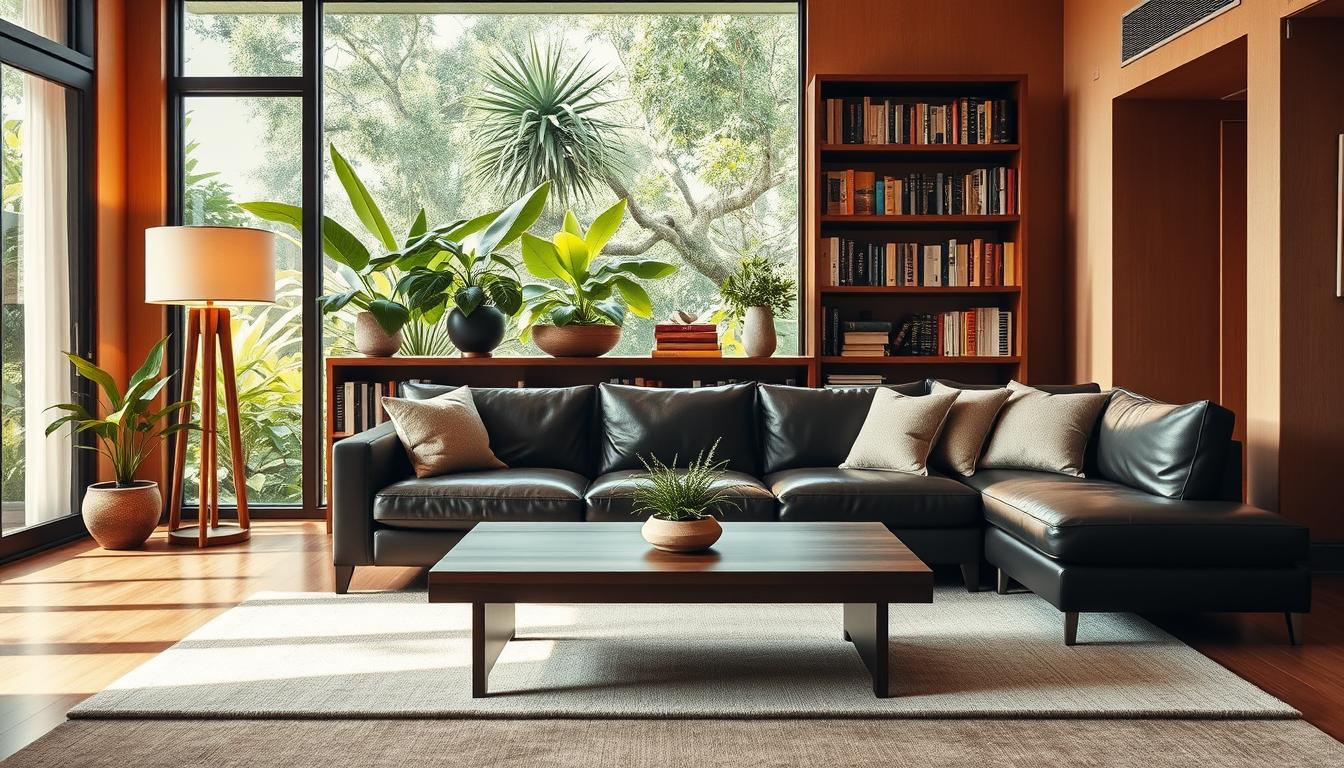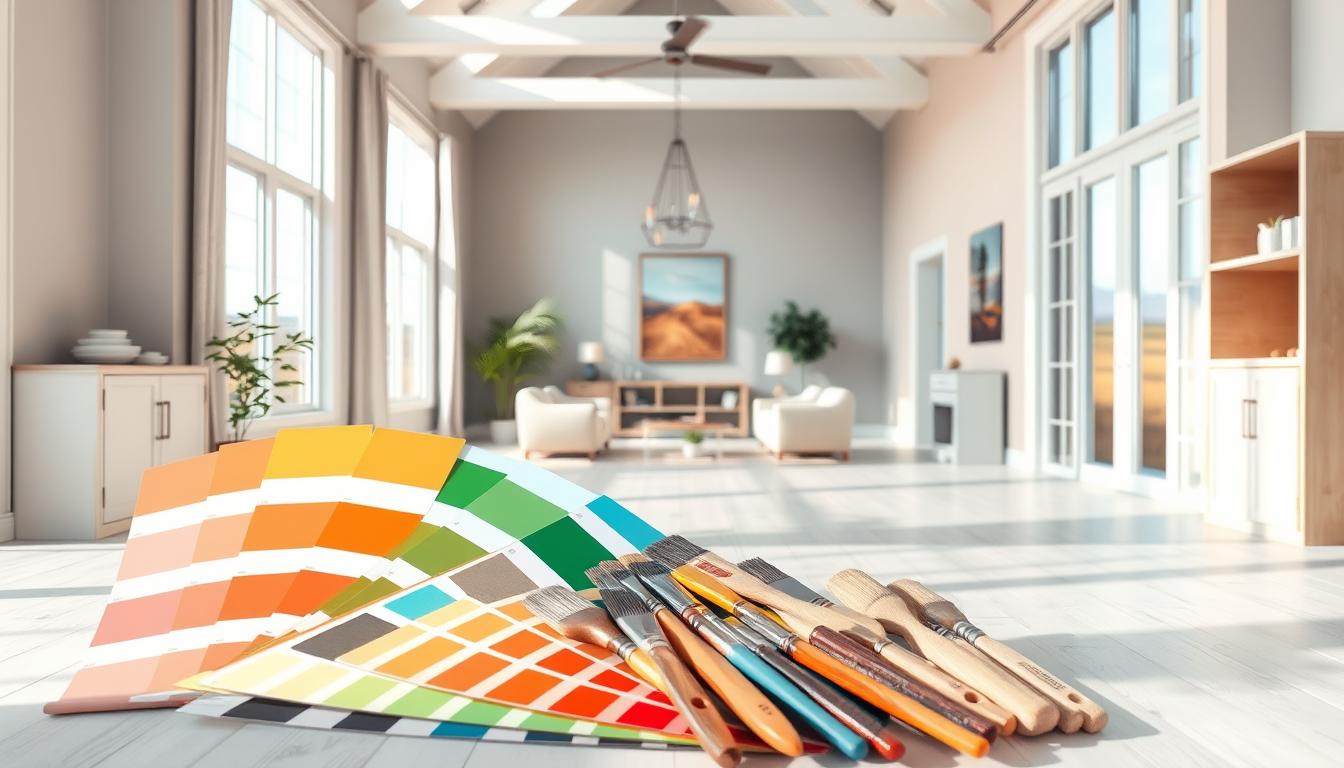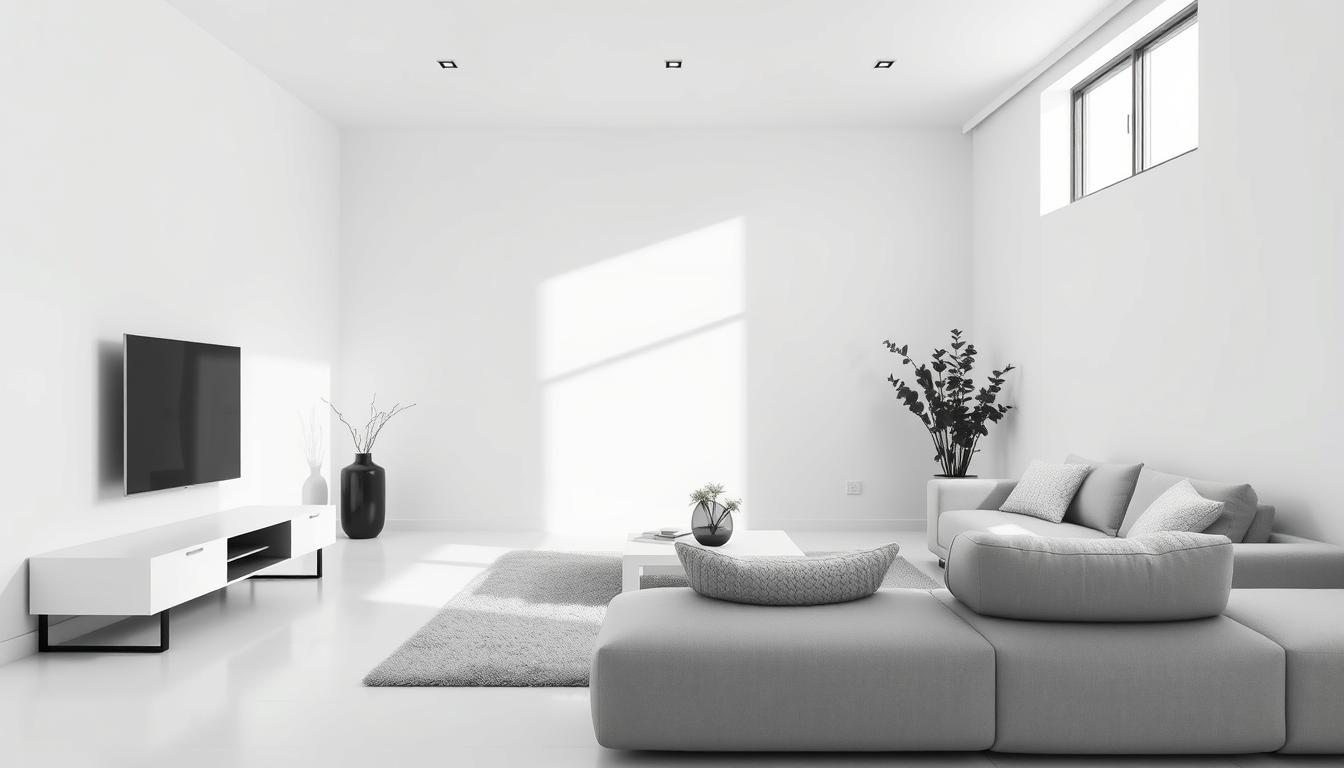Did you know that adding cultural elements to home design can make a space more beautiful and meaningful? In Java, the culture shines through in intricate patterns and natural materials in traditional buildings. We use this mix of culture and design to help you create a Java-inspired look in your living space.
By mixing personal stories with creativity, we can make a home interior that shows who you are. It also celebrates Javanese culture. Our guide will show you how to do this, with tips on the unique features of this style.
Key Takeaways
- Understanding the cultural significance of Javanese design elements
- Incorporating natural materials and patterns into your decor
- Blending traditional inspiration with modern personal style
- Creating a space that tells your personal story
- Embracing the beauty of cultural heritage in home design
Understanding the Essence of Java Home Design
Java home design blends function with traditional Javanese art. It’s not just about looks; it’s about a space that shows Java’s culture and beauty. This design style reflects the island’s rich heritage and natural wonders.
Exploring Java style home decor, we see its roots in the island’s art and culture. Java’s history as a cultural mix has shaped a unique design. It’s elegant yet simple.
What is Java Home Interior?
Java home interior design focuses on natural materials and earthy tones. It combines traditional and modern elements. This approach aims to merge the outdoors with indoor living spaces.
In a Java-inspired home, you’ll find wooden furniture, natural stone, and woven textiles. These elements warm the space and connect it to nature.
Key Elements of Java-Inspired Spaces
What makes Java-inspired spaces unique? They often use a neutral color palette with earthy tones like beige, brown, and green. Natural materials and a focus on sustainability are key.
Adding interior design ideas from Java style, like local artwork and traditional furniture, enriches your space. It’s about creating a home that’s not just beautiful but also tells your story.
Color Palette: Earthy Tones and Natural Hues
Earthy tones and natural hues are key in Java-inspired interiors. They bring warmth and peace to your home. Using elements that reflect nature can greatly improve your living space’s feel.
To get a Java-inspired look, understanding color’s role is important. The right colors can make your home feel cozy and inviting.
Choosing the Right Colors for Your Interior
Choosing colors for your Java-inspired interior means thinking about Java’s natural world. Use earthy tones like terracotta, sienna, and umber. Also, consider natural colors like green and blue, inspired by Java’s green landscapes and blue waters.
- Terracotta and sienna shades for a warm, earthy feel
- Soft greens to bring in the essence of Java’s lush vegetation
- Calming blues inspired by the island’s serene waters
These colors not only make your space calm but also connect it to Java’s natural beauty.
Incorporating Bold Accents
While earthy tones and natural hues are the foundation, bold accents add depth and character. Use vibrant colors or rich textures through textiles, artwork, or decorative pieces to highlight areas in your rooms.
By mixing earthy tones with bold accents, you create a unique space. It shows the spirit of Java and your personal style.
Materials Matter: Sustainable Choices
Java-inspired interiors focus on natural and sustainable materials. These materials boost the look and help the environment. By picking materials that are good for the planet, you make a space that’s both beautiful and eco-friendly.
Common Materials Used in Java Interiors
Java interiors often use teak wood, bamboo, and rattan. These materials are strong and good for the planet. They add warmth and texture to any room.
Teak wood is great for furniture because it lasts long and resists pests. Bamboo is valued for being sustainable and flexible. Rattan furniture is light and natural-looking.
| Material | Characteristics | Uses in Java Interiors |
|---|---|---|
| Teak Wood | Durable, resistant to pests and decay | Furniture, flooring |
| Bamboo | Sustainable, versatile, lightweight | Furniture, decorative elements |
| Rattan | Natural look, lightweight, durable | Furniture, wall decor |
Benefits of Natural Materials
Using natural materials in your design supports sustainable living. They add depth, texture, and warmth. This makes your space cozy and welcoming.
Natural materials are also durable and need less care than synthetic ones. Choosing them helps the environment and is practical for decorating. It’s a way to live more sustainably.
When using these materials, think about how to decorate your space. Mixing natural materials with careful decor creates a harmonious, eco-friendly home.
Furniture Styles: Embracing Authenticity
Authenticity is crucial in furniture design to achieve a true Java look in your home. It’s important to pick furniture that shows Java’s rich culture and fits well with today’s lifestyle.
Traditional Java Furniture Designs
Traditional Java furniture is known for its detailed carvings, elegant shapes, and connection to nature. Teak wood is a key material, loved for its strength and stunning grain.
- Intricately carved wooden chairs and tables that showcase the artisan’s skill.
- Ornate door panels and cabinets that add a touch of traditional elegance.
- Handcrafted wooden beds with intricate carvings that become a centerpiece in any room.
Modern Interpretations of Java Pieces
Modern takes on Java designs bring a fresh, contemporary vibe. By mixing traditional skills with new materials and styles, we can make a unique, stylish home.
- Combining teak wood with modern metallic accents for a sleek, contemporary look.
- Incorporating minimalist designs with intricate Javanese carvings for a blend of old and new.
- Using reclaimed wood and sustainable materials to add an eco-friendly dimension to your decor.
By mixing traditional and modern furniture, we can make a home that’s stylish and full of cultural heritage.
Lighting: Creating the Right Ambiance
The essence of a Java-inspired interior is significantly enhanced by the thoughtful use of lighting. In Java-style homes, lighting is not just about illumination. It’s about creating an ambiance that reflects the rich cultural heritage and natural beauty of Java.
Natural Light vs. Artificial Lighting
A key aspect of Java-inspired interior design is the balance between natural and artificial light. Maximizing natural light is crucial, as it highlights the natural textures and colors characteristic of Java style. Large windows and open layouts can help achieve this. But artificial lighting is also important, for when natural light is scarce.
Artificial lighting in Java-inspired homes often features warm tones and soft glows, mimicking the natural light. This can be achieved through the use of table lamps, floor lamps, or string lights with natural materials like wood, rattan, or bamboo.
Choosing Fixtures that Reflect Java Style
When selecting lighting fixtures for a Java-inspired home, it’s essential to choose pieces that reflect the traditional craftsmanship and natural aesthetic of Java. Look for fixtures made from natural materials or those that incorporate traditional Java designs.
Some interior design ideas include using lanterns made from natural fibers, pendant lights crafted from wood or rattan, or even repurposed traditional Java lanterns. These not only provide light but also serve as decorative pieces that enhance the Java style home decor.
By thoughtfully combining natural and artificial lighting and choosing fixtures that echo Java’s rich cultural heritage, you can create a warm and inviting atmosphere. This atmosphere embodies the spirit of Java-inspired interior design.
Textiles and Fabrics: Adding Layers
Local textiles and fabrics are key in Java home interior design. They add depth and warmth to your space. You can mix traditional and modern fabrics for a unique look.
Selecting Local Textiles for Your Home
When picking textiles for your Java-inspired home, look for materials that show local culture and skill. You can find authentic fabrics at local markets or online stores that focus on Java textiles.
Some popular local textiles include:
- Batik fabrics with intricate patterns and designs
- Hand-woven fabrics made from natural fibers like cotton and silk
- Traditional Java motifs, such as parang and kawung patterns
Mixing Patterns and Textures
To make your space look good, mix patterns and textures well. Start by combining fabrics like smooth silk and rough cotton. This adds depth to your decor.
| Pattern | Texture | Effect |
|---|---|---|
| Batik | Smooth | Creates a sense of calm |
| Hand-woven | Rough | Adds warmth and coziness |
| Traditional motifs | Varied | Brings cultural authenticity |
By mixing patterns and textures, you can make your Java-inspired home unique and welcoming. For more interior decorating tips, check out local artisan shops and online resources.
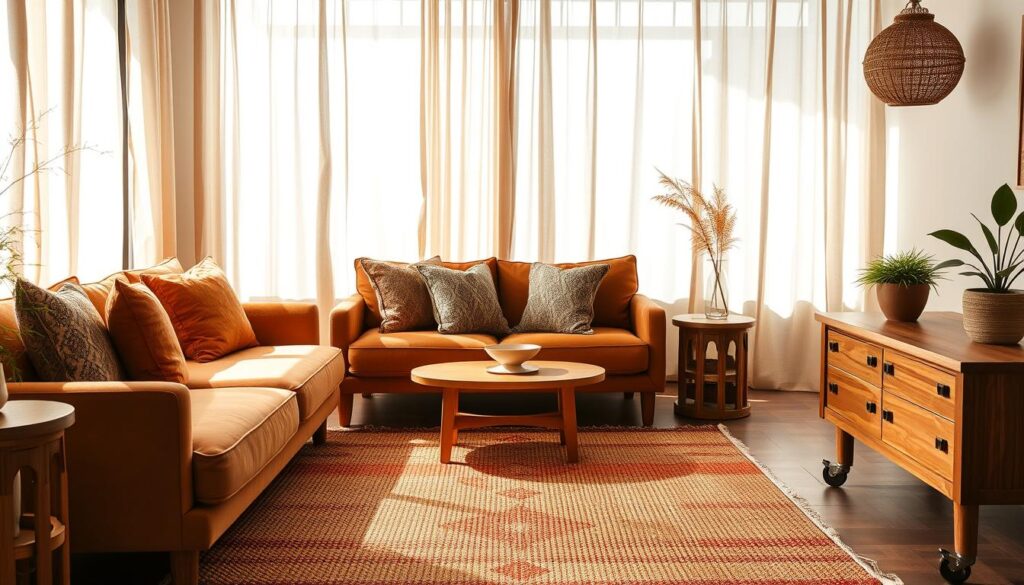
Decorative Accents: Showcasing Culture
Decorative accents can bring Java’s essence into your home. They mix traditional craftsmanship with modern style. These accents add beauty and show off Java’s rich culture.
Incorporating Artisan Crafts
Java is known for its artisan crafts. You can add these crafts to your home in many ways. For example:
- Handwoven baskets and textiles warm up your living spaces.
- Intricate wooden pieces show off Javanese artisans’ skills.
- Pottery and ceramics add a natural feel to your home.
Using these crafts makes your home look better. It also helps local artisans and keeps traditional crafts alive.
Utilizing Local Artwork and Sculptures
Local artwork and sculptures are great for showing Java’s culture. You can find:
- Traditional paintings of Javanese myths and daily life.
- Sculptures of figures from local stories, made from wood or stone.
- Modern art that mixes new techniques with old themes.
These pieces add depth and stories to your home. They make it a true reflection of Java’s culture. For a stylish home interior, mix these with modern decor for a unique look.
In summary, decorative accents like artisan crafts and local artwork are key for a Java-inspired home. They make your home both beautiful and connected to Java’s culture. This enhances your home improvement journey.
Bringing Nature Indoors: Biophilic Design
Exploring Java home interiors shows us the importance of nature inside. Biophilic design connects us to nature, making our homes feel more like a part of it. It makes our spaces look better and helps us feel better too.
Benefits of Indoor Plants
Indoor plants are key in biophilic design. They clean the air, lower stress, and make us happier. The main benefits include:
- Improved air quality
- Enhanced mental health
- Increased productivity
- Aesthetic appeal
Adding indoor plants to our Java-inspired homes can be done in many ways. We can use traditional planters or even create a living wall.
Suitable Plants for Java-Inspired Homes
Choosing plants for a Java-inspired home means picking ones that show the region’s beauty. Some great choices are:
- Orchids, native to Java and add an exotic feel
- Bamboo, symbolizing good fortune and strength
- Ferns, which love shade and remind us of lush forests
These plants bring a bit of Java’s nature inside. They help make our homes calm and peaceful.
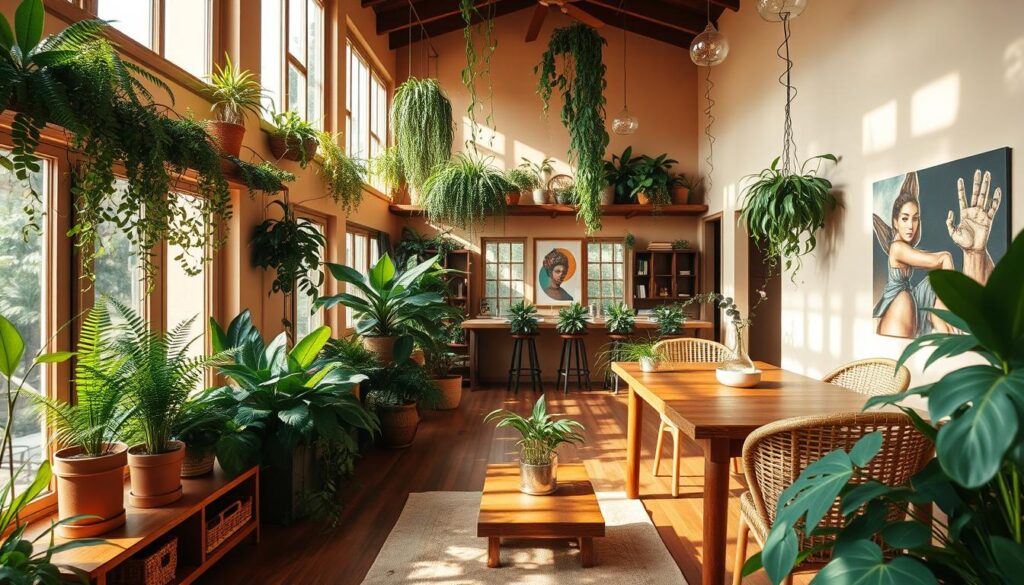
By using biophilic design and adding indoor plants, we make our homes both beautiful and caring. This way of designing interiors helps us live in harmony with nature. It leads to a healthier and more balanced life.
Outdoor Spaces: Extending Your Java Aesthetic
Java’s calm and earthy vibe can turn your outdoor area into a cozy retreat. It’s more than looks; it’s about living in harmony with nature. This way, we make our outdoor spaces a part of our Java-inspired home.
Designing an Inviting Outdoor Area
To make an outdoor area welcoming, we should think about Java’s natural beauty and culture. Use natural materials like teak wood and woven fibers for furniture and decor. These choices are not only eco-friendly but also warm and textured.
Key considerations for an inviting outdoor space include:
- Comfortable seating areas that encourage relaxation and social interaction
- Incorporating lush greenery and tropical plants to bring in a touch of Java’s lush landscapes
- Soft lighting that enhances the ambiance in the evening
Incorporating Water Features
Water features add a serene touch to outdoor spaces, just like Java’s natural landscapes. Adding small ponds, fountains, or a gentle waterfall can make your outdoor area even more calming.
“The sound of water is not just a backdrop; it’s an experience that soothes the soul and connects us to nature.”
When adding water features, think about the size of your space and the style of your Java-inspired home. Also, remember to keep maintenance easy.
By designing our outdoor spaces with Java-inspired elements, we grow our living areas. We also create a smooth connection between our indoor and outdoor spaces.
Java-Inspired Home Décor: Where to Shop
Looking for the perfect Java-inspired decor can be exciting. With the right places to shop, you can bring Java’s essence into your home. It’s important to find decor that shows Java’s cultural richness and beauty.
Local Markets and Artisan Shops
Local markets and artisan shops are great for finding authentic Java decor. They offer unique, handmade items that capture Java’s spirit. You can find everything from carved wooden furniture to colorful textiles.
Benefits of Shopping Locally:
- Unique, one-of-a-kind pieces
- Direct support for local artisans and communities
- Opportunity to learn about the craftsmanship and stories behind the decor
When you’re at local markets, look for traditional Java items. Batik fabrics and hand-carved wooden decorations are great finds.
Online Resources for Authentic Pieces
Shopping for Java-inspired decor online is easy today. Many websites and stores sell authentic Java-style home decor. They offer a wide selection and can ship worldwide.
Tips for Shopping Online:
- Research sellers to ensure they source their products ethically and directly from artisans
- Read reviews and product descriptions carefully to verify authenticity
- Look for online stores that provide detailed information about the craftsmanship and materials used
By shopping locally and online, you can create a Java-inspired home that’s truly yours.
Final Thoughts: Personalizing Your Java Home
As we wrap up our guide to a Java-inspired home, remember personalization is key. Your home should show off your unique style and tastes. It should mix Java design with your own flair.
Adding Personal Touches
To make your Java home truly yours, add personal touches. This could be family heirlooms, your own artwork, or special decorative items. These add an emotional layer to your space, making it stylish and meaningful.
Balancing Aesthetic and Functionality
Java design focuses on looks, but function is also crucial. Choose improvements that are both beautiful and practical. This makes your home comfortable and efficient for daily life.
By following Java home design and adding your personal style, you create a stunning and meaningful space. This mix of Java inspiration and personal touches makes your home unique. It reflects your journey and experiences.

